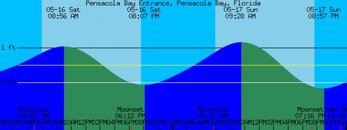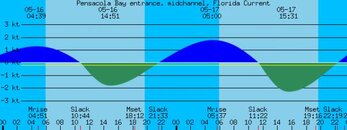Main Question: When is it safe to shore dive with tides?
I am advanced certified and have only done boat dives. I have recently moved near the beach and I want to start shore diving more. I have done some basic research and have figured out that high tide is sully the best time to dive during the transition stage where the water is still. I know this ranges from about 1hr on either side etc., but at what point (tidal range & tidal current speed) do you need to worry about how strong the tide current is? the place I'm looking to dive (Ft Pickens in Pensacola, FL) only has a tidal range of about 1ft to 1.5ft (~0.3-.5m) with what appears to be 1-1.2kt current. Is this significant enough to worry about? The park opens at 10am, and the high tide is at 9:30am, with there being only 1 high tide and 1 low tide each day (low tide at about 9PM). Thus, the entire day is from high tide --> low tide. I also know local information is the best way to go and I plan on doing that research. My question is what is the general rule for tidal ranges, tidal current speed, and times of tide for safe scuba diving? (i.e. 60min on either side of high or low tide, or anywhere between 60 min before low tide till 60 min after high tide-assumption being the current would be pulling me to shore so as long as I can swim out against it the current shouldn't be a problem)
I have looked for a book or certification book I can buy on Amazon or eBay without any luck. Any personal knowledge or links to resources would be greatly appreciated!
Thanks!
-Farra
I am advanced certified and have only done boat dives. I have recently moved near the beach and I want to start shore diving more. I have done some basic research and have figured out that high tide is sully the best time to dive during the transition stage where the water is still. I know this ranges from about 1hr on either side etc., but at what point (tidal range & tidal current speed) do you need to worry about how strong the tide current is? the place I'm looking to dive (Ft Pickens in Pensacola, FL) only has a tidal range of about 1ft to 1.5ft (~0.3-.5m) with what appears to be 1-1.2kt current. Is this significant enough to worry about? The park opens at 10am, and the high tide is at 9:30am, with there being only 1 high tide and 1 low tide each day (low tide at about 9PM). Thus, the entire day is from high tide --> low tide. I also know local information is the best way to go and I plan on doing that research. My question is what is the general rule for tidal ranges, tidal current speed, and times of tide for safe scuba diving? (i.e. 60min on either side of high or low tide, or anywhere between 60 min before low tide till 60 min after high tide-assumption being the current would be pulling me to shore so as long as I can swim out against it the current shouldn't be a problem)
I have looked for a book or certification book I can buy on Amazon or eBay without any luck. Any personal knowledge or links to resources would be greatly appreciated!
Thanks!
-Farra





